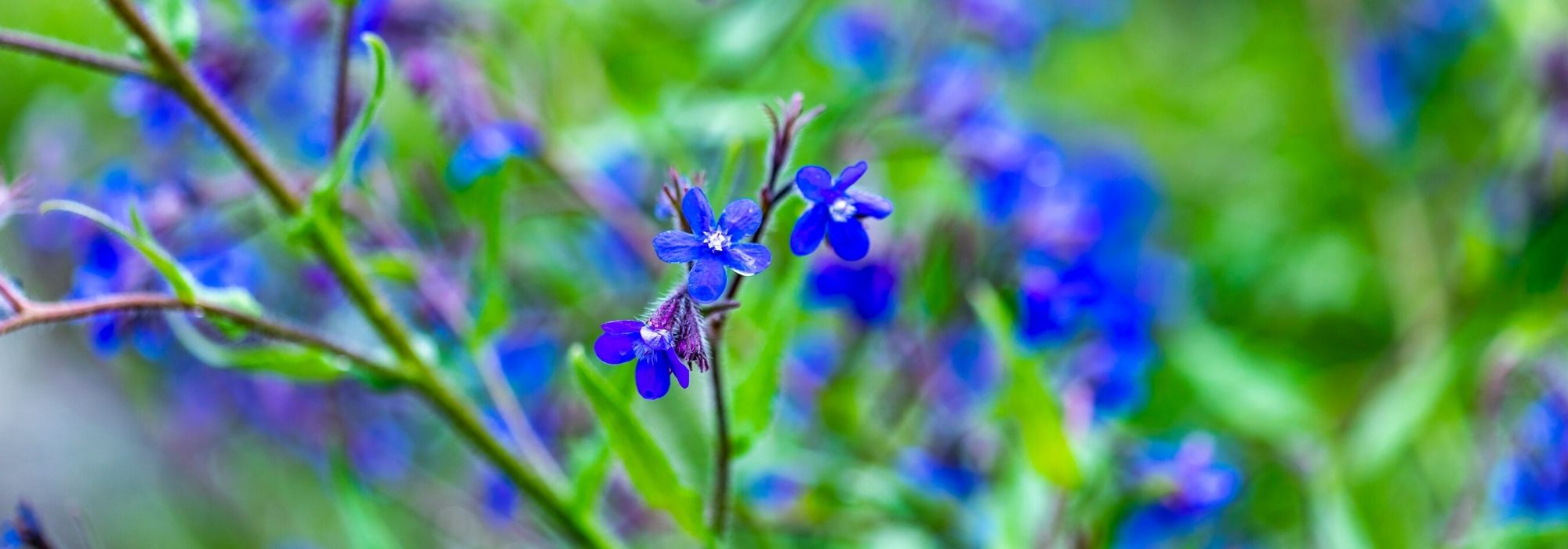
Bugloss, Anchusa: planting, growing
Contents
Bugloss in a nutshell
- Bugloss is a large perennial plant that spreads quickly and forms beautiful clumps of rough leaves
- It produces spikes of intensely blue flowers, among the most beautiful in our gardens
- It is a plant with a accommodating character, very hardy and low in water requirements
- It enjoys full sun and rich neutral to calcareous soils
- Stunning in a ‘Cottage’ style border, it is a must-have for church gardens, dry gardens, or rockeries
A word from our expert
Anchusa or Bugloss is a deciduous plant that offers, in summer, a beautiful flowering of a particularly intense blue. Among the most remarkable anchusa perennials is the Italian Bugloss, which produces flower spikes up to 1.5m tall with Anchusa azurea ‘Dropmore’, dense and generous with ‘Loddon Royalist‘ or edible with the common bugloss.
Easy to grow, plant it in the sun in rich, deep, light soil, in slightly wild corners.
With its bushy silhouette, starry flowering, and accommodating nature, it will add a casual touch to your summer borders and rockeries.
You will be surprised by its exceptional colours!
Description and botany
Botanical data
- Latin name Anchusa
- Family Boraginaceae
- Common name Bugloss, alkanet, Viiper's bugloss
- Flowering May-September
- Height 0.30 to 1.50 m
- Exposure Sun
- Soil type rich and light
- Hardiness -15 to -20°C
Anchusa, the bugloss is an annual, biennial, or perennial herbaceous plant from the Boraginaceae family, a cousin of borage and forget-me-not.
It is native to Southern Europe and Asia, found naturally in dry, sunny fields and slopes, often stony and calcareous, in meadows or on banks, along paths throughout almost all of France and Corsica.
The genus comprises about 35 species, among the most common in our region:
- Italian bugloss (Anchusa azurea) with cultivars ‘Dropmore’, ‘Loddon Royalist’
- Cape bugloss (Anchusa capensis), which are biennials
- Common bugloss (Anchusa officinalis)
With a significant radicular system, the bugloss forms an upright, bushy clump in two years of cultivation, varying in height depending on the species and varieties, but averaging 80 cm in height and 60 cm in width. Under optimal growing conditions, some varieties in rich, moist soil can reach heights of up to 1.80 m.
The upright, branched, and twiggy stems bear medium to dark green, alternate, oblong, and lanceolate leaves. The basal leaves of the clump are larger and long-petiolate, forming a rosette, while the upper leaves are without petioles. The entire plant is covered in the characteristic rough hairs of the Boraginaceae family. This deciduous foliage has a coarse texture and a rough touch.
Throughout spring and into the heart of summer, from May to September, these tall stems covered in stiff hairs bear clusters of small star-shaped flowers arranged in axillary or terminal cymes. They bloom from the top of the stem downwards.
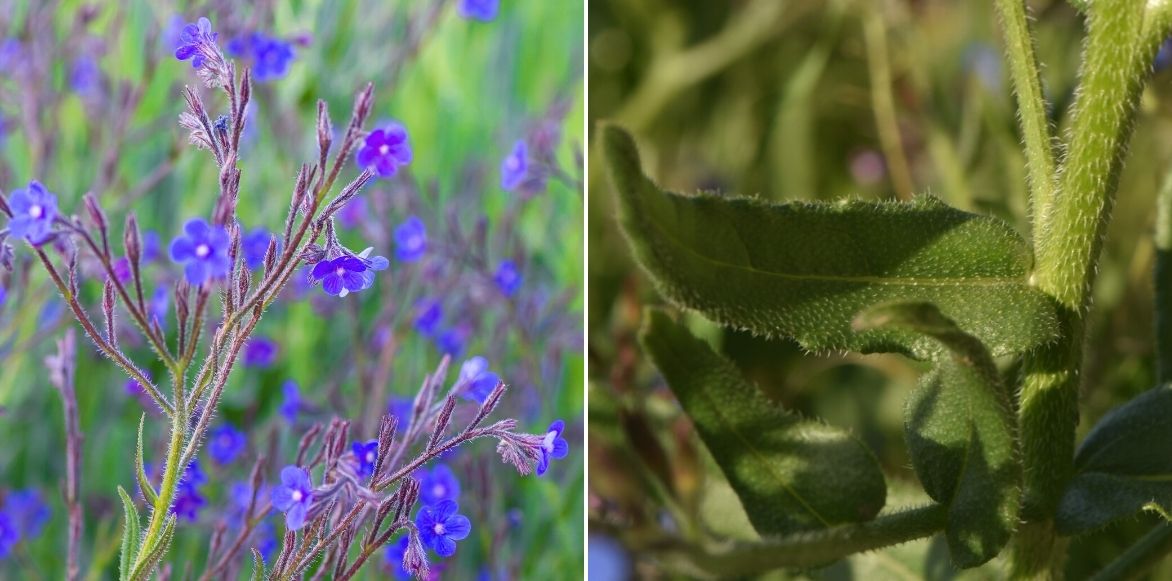 Anchusa azurea: superb flowering and foliage with hairy stems, typical of the Boraginaceae
Anchusa azurea: superb flowering and foliage with hairy stems, typical of the Boraginaceae
They measure 1 to 2 cm in diameter and consist of five rounded, well-defined petals arranged in a star shape to form a bell. They feature a white eye at their centre, contrasting beautifully with their pure, saturated, and intense blue colour, a rare and luminous gentian to forget-me-not blue. They are less commonly found in white or pink.
Versatile, the Bugloss can thrive anywhere: in borders, pots, in the wildflower beds of cottage gardens, in natural or wild gardens, or even in the vegetable garden where its melliferous flowers will irresistibly attract pollinating insects.
“`
Main species and varieties
Most popular
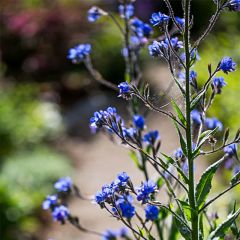
Anchusa azurea Dropmore
- Flowering time June, July
- Height at maturity 90 cm
Our favourites
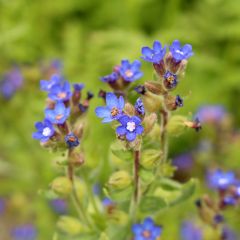
Anchusa azurea Loddon Royalist
- Flowering time July to October
- Height at maturity 80 cm
Discover other Anchusa
View all →Available in 2 sizes
Available in 1 sizes
Planting and sowing of borage
Where to plant it?
Not very demanding, the Bugloss easily thrives in all our gardens. Perennial species like Italian bugloss are moderately hardy down to -7/-10°C. It is a short-lived perennial, but fortunately, the plant can self-seed year after year after flowering in light soils.
Easy to cultivate, it prefers rich and fairly substantial yet light soils: the soil should be deep, fertile, loose, neutral to calcareous, and perfectly drained. It tolerates calcareous soils that will enhance the colour of its flowers.
On the other hand, it will struggle in heavy, waterlogged soils in winter that can rot its roots.
Plant it in full sun, and in warmth; it can even tolerate occasional drought. It will prefer a semi-shaded position in our warmest regions to preserve the colour of the flower.
Provide it with a nice location where it can thrive comfortably, as it spreads quickly and forms large clumps. It makes an excellent subject for rockeries, flower beds, adding relief and lightness to borders or cottage-style beds, and even in pots. The common bugloss, for its part, will reign in the vegetable garden or in the herb garden.
When to plant bugloss?
The planting of our buglosses in pots takes place in spring, from February to May, or in autumn from September to November, avoiding frost and extreme heat.
How to plant it?
In open ground
Plan for 5 plants per m², spaced 50 to 80 cm apart depending on height in all directions.
- Loosen the soil well,
- Dig a hole three times the volume of the root ball,
- Spread gravel at the bottom of the planting hole,
- Place the root ball,
- Backfill with garden soil mixed with compost,
- Firm down,
- Water generously.
In a pot
Choose a pot with drainage holes at least 30 cm high, in which you will have spread a layer of gravel or clay balls.
- Plant the root ball in a well-draining mix of garden soil, coarse sand, and potting soil,
- Water as soon as the soil dries out.
How to sow it?
You can also sow bugloss seeds that you have collected in trays or pots from February under cover: transplant to the garden when the seedlings have 4-5 leaves; the root is fragile, so transplant with care.
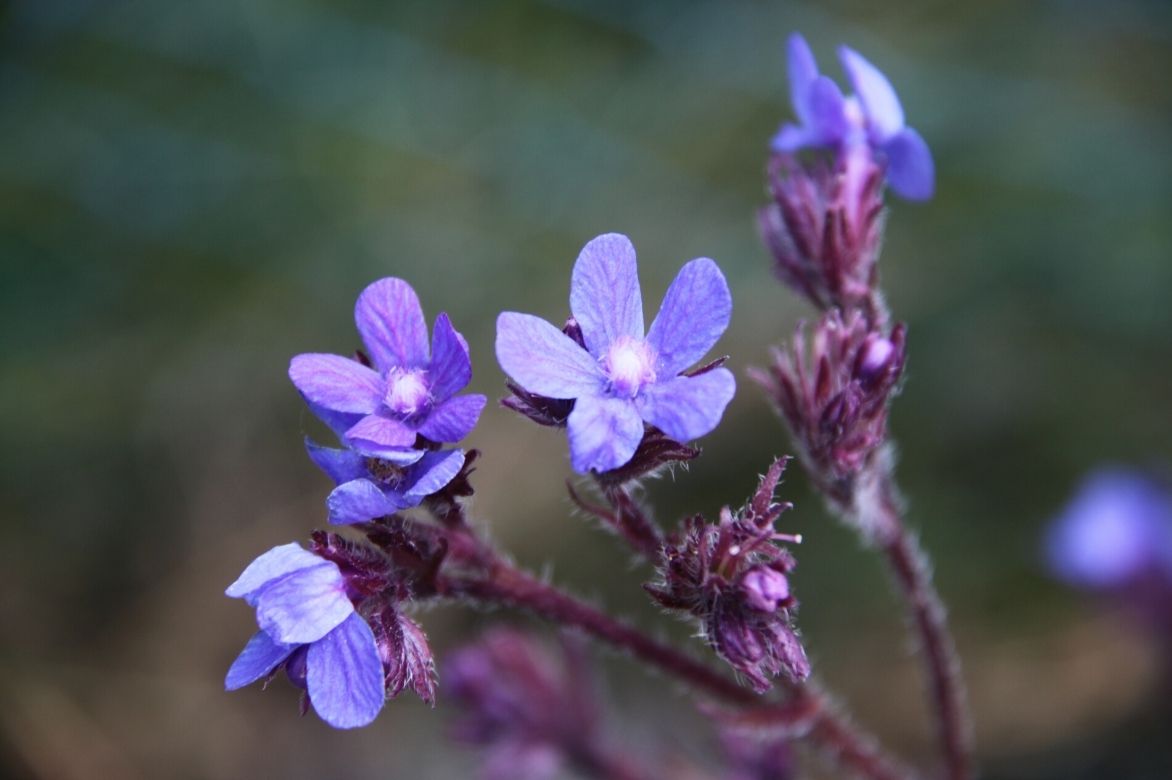
A closer look at the beautiful small flowers of Anchusa azurea ‘Dropmore’
Care
The Bugloss is a very low-maintenance plant that requires little water. It fits well in dry or rocky gardens: only water it if the weather is dry.
Do not hesitate to stake if the flower spikes become heavy with blooms. Remove faded flowers to encourage further flowering.
Cut back the clumps after flowering if you wish to enjoy self-sowing: leave a few stems.
Add compost in autumn.
Divide every three to four years, in autumn or winter.
Possible diseases
In hot and humid weather, this plant, which is otherwise very resilient, is primarily threatened by powdery mildew, which covers the foliage with a white fluff. As a preventive measure: water at the base without wetting the foliage and spray with nettle manure or a horsetail decoction. You will find our tips for combating white disease in our article.
Aphids can transmit the mosaic virus, which causes yellowish spots on the leaves: uproot the diseased plants and deter aphids by placing trap plants nearby, such as nasturtiums, for example.
Propagation
If you already have a young plant of bugloss in your garden, collect some seeds at the end of summer and sow them in spring to propagate it. This plant is also easy to multiply by propagation by cuttings or by division of clumps. As bugloss tends to exhaust quite quickly, dividing and propagating it regularly (ideally every three to four years) will allow you to obtain more vigorous young plants.
Division of clumps
- In spring, lift the stump with a fork
- Divide it into several sections that you will replant immediately in the garden in well-aerated and enriched soil
Root cuttings
- Take sections of roots by cutting it at the base with a knife
- Remove the leaves
- Insert them into trays filled with potting mix, pushing them sufficiently into the substrate
- Water and place under a cold frame
- Transplant into pots filled with substrate when they have 4 or 5 leaves
- Plant them in their final position in the ground in autumn
Pairing ideas
Very accommodating, the Bugloss will find its place in all natural and wild gardens, dry gardens, in the country-style flower beds of a cottage garden, or in a vicar’s garden.
In a flower bed or a mixed-border that requires little maintenance and is low in water, it will accompany viper’s bugloss (Echium vulgare), the beautiful purple Lysimachia, Euphorbias, large thistles, hybrid mulleins, nepetas, and other cottage perennials such as lupins, cornflowers, centauries, yarrow, phlox, corn poppies, cosmos, daisies, and anthemis…
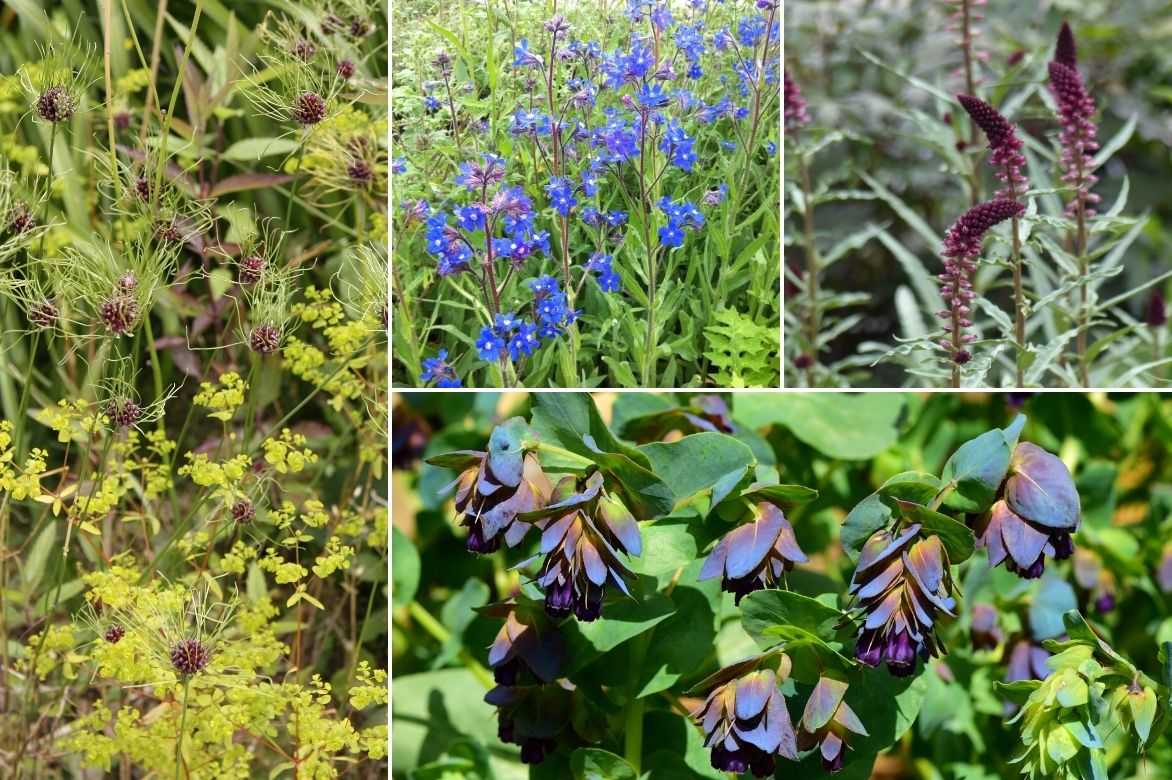
An example of association in well-drained soil: Allium ‘Hair’ and Euphorbia seguieriana ssp. niciciana, Anchusa azurea ‘Loddon Royalist’, Lysimachia atropurpurea ‘Beaujolais’ and Cerinthe major
It is essential in blue gardens. Plant it with other highly floriferous plants such as delphiniums, the geranium ‘Rozanne’, aconites, veronicas, verbena hastata, ornamental alliums, and campanulas to create a azure flower bed. You will particularly highlight the blue hues of the bugloss by contrasting it with the aniseed flowers of Alchemilla or Solidago altissima. You will compose a scene of romantic inspiration by planting it at the foot of roses, shrubby lavateras, and Buddleias.
With its melliferous flowering, the bugloss attracts many pollinating insects and will also be wisely placed near the vegetable garden or in the herb squares for common bugloss.
Useful resources
- Discover our selection of hardy and easy perennials to adopt in a medieval garden.
- Discover our selection of 15 medicinal plants to grow in your garden!
- Subscribe!
- Contents
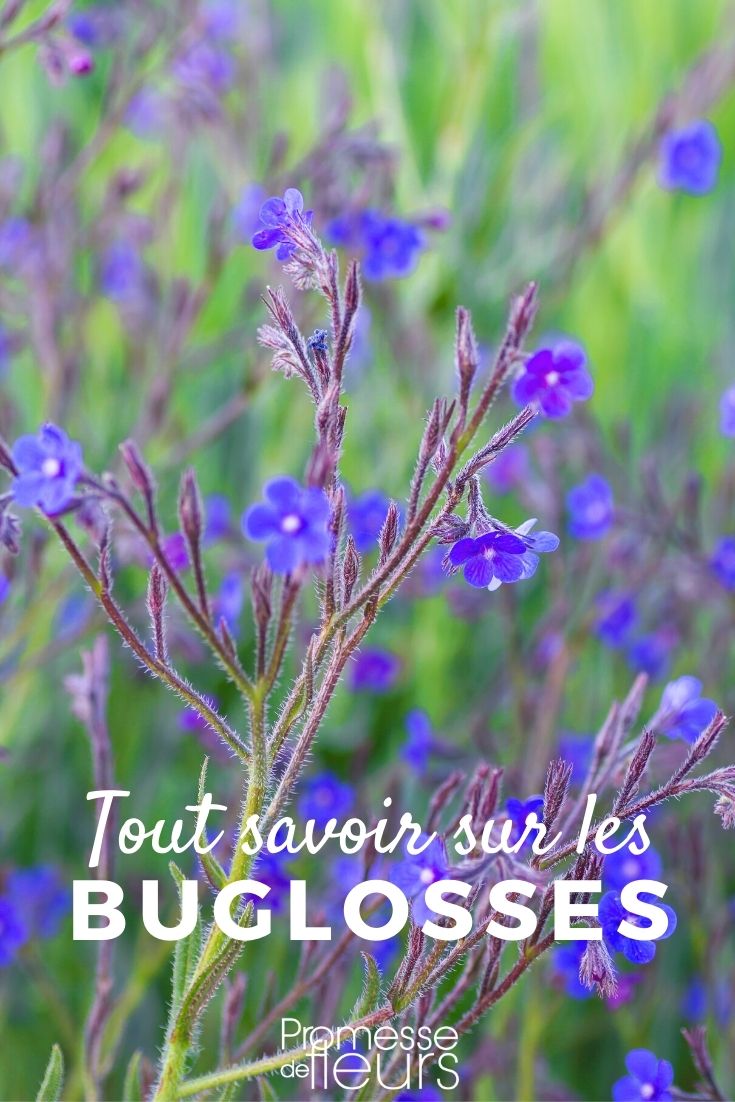

































Comments